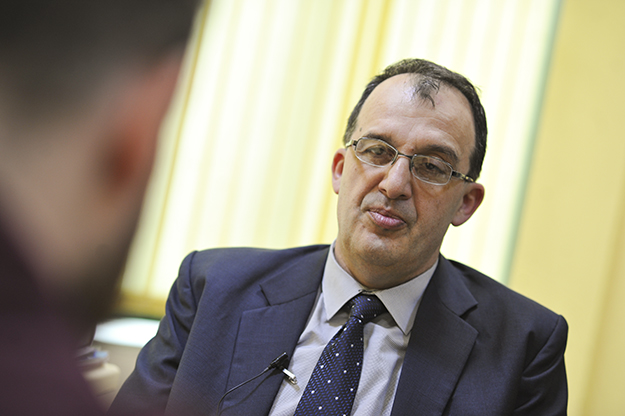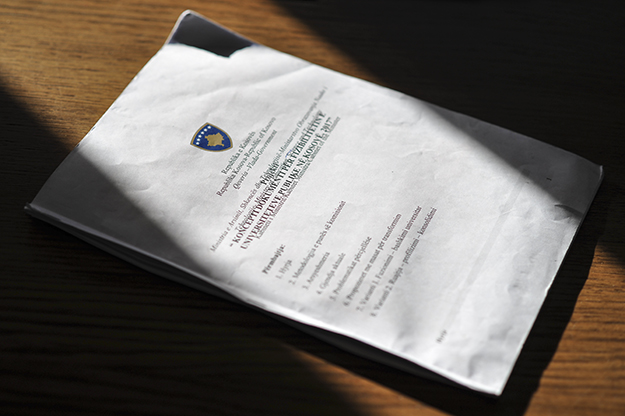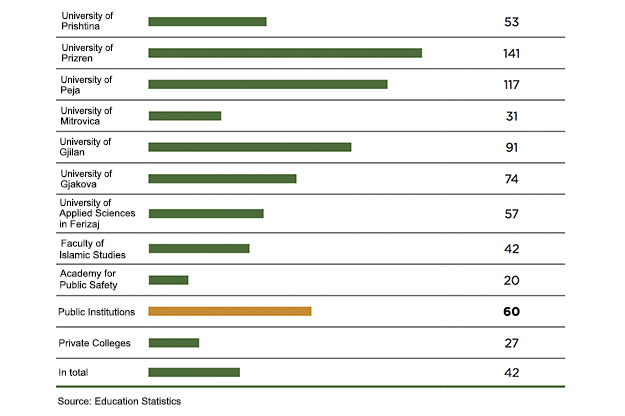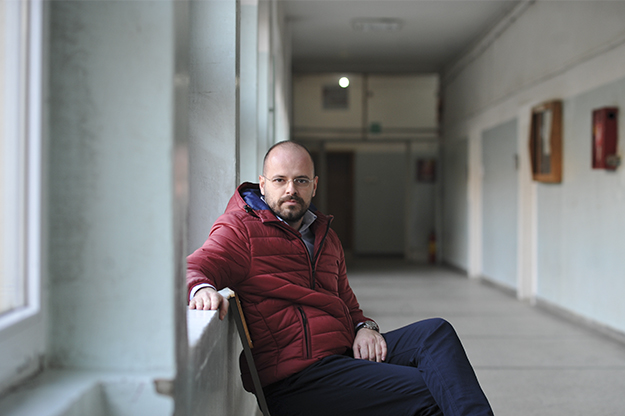In 2010, Hashim Thaçi, as prime minister of the state announced the establishment of public universities in multiple cities in Kosovo. In the first week of October of that year, Thaçi was in Peja where, accompanied by his subordinates, he met with citizens and officials from the Municipality of Peja, and visited businesses in the city.
With the academic year having started at the time, he did not leave without meeting the leaders and students of the Faculty of Applied Business Science in Peja, which at the time functioned as part of the University of Prishtina (UP). He promised them that from October 2011, their faculty would be transformed into a university. A week later, Thaçi was in Mitrovica — and even there he promised to transform the UP’s Faculty of Mining and Metallurgy into a university.
He visited the two cities about one month before a motion of no confidence was issued against his government — initiated by his own party, PDK — and about two months before the parliamentary election, which would be set for December 12, 2010.
Thaçi told the students that he would “eliminate every possibility” of the university not being opened in case of eventual changes in government. However, he wasn’t faced with this concern, since he managed to win the election. He kept these promises.
On November 14, 2011, PDK member and then Minister of Education Ramë Buja signed the decision to establish the Haxhi Zeka public university in Peja. A year later, the Assembly ratified the decision. The decision to establish the university in Mitrovica was approved by deputies in May 2013.
The momentum for opening public universities had been started by Thaçi in 2009 with the establishment of the Ukshin Hoti university in Prizren. During his second mandate as prime minister, three other universities were founded: the Kadri Zeka university in Gjilan (2013); the Fehmi Agani university in Gjakova (2013); and the University of Applied Sciences in Ferizaj (2015).
Even after their establishment, Thaçi’s PDK continued to use them for the election campaign. Under the slogan ‘The New Mission,’ in 2014 Thaçi described their establishment as a “vision” for the “modernization” of the country and as a catalyst for opening new jobs and for economic development.
Before the students of the ‘Ukshin Hoti’ University of Prizren he pledged: “I will be committed to providing you with the highest quality education in our public universities throughout the Republic of Kosovo, and to ensure that your studies here match the labor market offer beyond these walls.”
Although the promises he made on establishing the new universities were realized, experts have continuously expressed skepticism about the claimed increase in the quality of higher education in the country.
There are claims that the opening of these universities has not brought about an increase in the quality of education because no monitoring mechanisms have been established to ensure this happens. Part of this criticism is highlighted in a report titled Concept Document for the Feasibility of Public Universities in Kosovo 2017, which was compiled by the Ministry of Education, Science and Technology (MEST) last year but has not yet been published — nevertheless, K2.0 has managed to secure it.
Illegal impromptu universities
One of the main critiques regarding these universities is interconnected with the fact that they were not established based on relevant plans or studies. So it is not clear how the government planned to increase the quality of education in these universities, how their programs would stimulate employment, how the required academic staff would be secured, or what effects — either short and long term — there would be on employment or the economy.
K2.0 asked MEST whether such plans exist, but the Ministry’s communication office, current adviser to the minister Valmir Gashi, and the Department for Higher Education, all failed to give any response.
The Director of Kosovo Education Center (KEC), Dukagjin Pupovci, who has long been involved in compiling education strategies, says that the establishment of public universities has never been mentioned in any of the strategies that have been compiled for higher education up until now.
“Without a studied plan, you can’t even open a primary school,” he says, adding that none of the universities were established based on a feasibility study. “The issues is that it is not just one such university, it’s six.”

Speaking about the establishment of new public universities, the director of Kosovo Education Center, Dukagjin Pupovci, says that with current legislation, they cannot be called universities. Photo: Atdhe Mulla / K2.0.
Pupovci highlights the case of the Kadri Zeka university in Gjilan, for which, he says, a document was presented as a “formal plan” before its establishment, but it was never subject to public discussion. He recalls one of the arguments in the plan, which stated that the university would provide study opportunities for residents of the Albanian-majority Presheva Valley in Serbia, but he says, such arguments do not say anything about the plans for education or science.
K2.0 requested the above mentioned plan from MEST, but they did not respond to the request.
Nevertheless, even current Education Minister Shyer Bytyqi stated in January 2018 that the six new public universities were opened “without prior evaluation.” “I don’t want to go into why all these universities were opened, but there was no evaluation of the necessity of opening public universities… and when we do things without prior evaluation, there is a huge risk of deterioration,” he told Kallxo.com, insisting on reviewing the work that the universities do.
Rinor Qehaja from EdGuard Institute, which conducts research on the quality of education, says that “the decision to establish other public universities was a political decision that would win points for political parties.” He says that they did not have educational interests in mind, and consequently they didn’t think about the need for developing Kosovar society.
“The programs at these universities do not provide any added value to the University of Prishtina,” he says.
Most of the new universities have the same faculties as those that exist at UP.
Outside of UP there are four faculties of law in other public universities (Prizren, Gjilan, Mitrovica and Peja) and just as many education faculties (Gjakova, Prizren, Gjilan and Mitrovica). There are also two faculties of philology, and one for each of architecture, arts and computer sciences in these six universities. Added to this are hundreds of programs in 22 private colleges that offer similar study opportunities.
The only additional faculties that UP doesn’t have are the faculties of tourism and environment, in Peja and Ferizaj; the Faculty of Agribusiness and Business in Peja; the Faculty of Geoscience and Food Technology in Mitrovica; and the Faculty of Life Science and the Environment in Prizren. The universities in Gjakova and Gjilan offer the same faculties that are offered in UP.

The MEST report, which has not yet been published but has been secured by K2.0, states that after the establishment of the new public universities, no control mechanisms have been created, the legal framework has not been fulfilled, and all this has negatively influenced the quality of the system. Photo: Atdhe Mulla / K2.0.
To facilitate the functionality of these universities, MEST established a working group, which became operational in November 2017, with the objective of providing a résumé of their, to evaluate them and to issue recommendations. Although the work of the working group was completed in March 2018, the report is yet to be published. However, K2.0 has managed to secure it.
The 20-page report starts by outlining the “necessity of realizing full higher education reform” and analyzing the expansion of higher education in Kosovo.
At bachelor’s level in Kosovo there are around 40,000 students registered at UP, and around 28,000 in other public universities. At master’s level, in all public universities there are 12,000 students. And at doctorate level, there are 399 students registered at UP. Moreover, there are tens of thousands of students in private colleges.
In public universities alone there are around 80,000 students, meaning Kosovo is ranked eighth in the world in terms of number of students relative to population size.
“The gross scale of registration in higher education is 84.23 percent… surpassing all European countries besides Greece, Spain, Belarus and Finland,” states a report published in March 2018 by the Kosovo Education and Employment Network (KEEN), a coalition of four NGOs working within education, employment and social policies.
The Ministry’s own report supports its higher education approach, which is based on a high number of students, but it concludes that the expansion has not produced positive effects.
“This expansion, although important as an education policy, has not been implemented in phases, and accompanied by studies,” the report says. “There is a chance that to a certain extent this factor will bring about a drastic decline in quality, instead of the expected improvement.”
Experts within the Ministry see the lack of a detailed strategy as the starting point of this failure. Such a strategy would have resulted in the creation of a model with long term objectives. In fact, the MEST report notes that the former administration “did not conduct an analysis of the real opportunities that the country has for employment, development and the orientation of higher education toward fulfilling current needs, or the future needs of the market.”
The report also states that public universities “have been artificially expanded and are replicating one another in structure and academic offers,” and that they have “branches that have no criteria and are not economically logical, thereby creating unnecessary and damaging competition” in the higher education sector. The academic offer is seen as having expanded “without prior planning, and unjustifiably when considering [Kosovo’s] size, the population and the Kosovar market demands.”
A report published by Gap Institute in May 2017 titled Professional Preparation for the Labour Market also states that the education system in Kosovo is not coordinated with the economy and the needs of the market, and that it yields students who are unqualified for work.
In a survey conducted with 28 businesses (small, medium and large), 82 percent stated that they “faced difficulties when seeking qualified workers.” Their lack of required skills made for a situation in which “53 percent of companies employed workers who are under qualified.” Meanwhile, over 42 percent of companies stated that this has hampered their productivity. The Gap Institute analysis concludes that curricula in all education sectors should be drafted based on the demands of the labor market.
The MEST report also speaks about the education quality of the new universities. “The hasty development of the system and the establishment of public universities was not accompanied by the expansion and establishment of control mechanisms, and the fulfillment of a legal framework, therefore this has negatively influenced education quality,” the report says. It also mentions that the poor quality of education in the six new universities is additionally being influenced by management issues.

Screenshot of KEEN’s report, Implementation of Kosovo Education Strategic Plan in 2017.
For EdGuard’s Qehaja, management issues and the lack of monitoring mechanisms have created a situation in which the work of these institutions is not monitored and consequently there is no guarantee of quality.
“These universities have been neglected. Institutions and other organizations don’t even write reports about them,” he says. “The focus is on UP. Nobody is dealing with other universities, and there are no monitoring mechanisms.”
The MEST report also mentions the cases of Peja’s Haxhi Zeka university and Prizren’s Ukshin Hoti university, stating that “contrary to the statutory provision regarding the positions of Prorector and Dean, pedagogues with the lower academic rank of Assistant Professor have been elected. By and large, this has had an impact on the management of the different parts of the universities, and in particular the management of education quality, is led by incompetent individuals who do not have the necessary academic experience.”
Moreover, the report mentions the academic advancement of professors in public universities as another issue. “Advancement and obtainment of academic titles, excluding UP to an extent, is beneath the minimum required level, and this has greatly compromised the process,” says the Ministry’s report, which also highlights that the process is being led without the necessary transparency of institutions and civil society.
Besides the general summary of the MEST report, there are few investigations and analyses regarding academic advancements in the other six public universities. The focus is once again more toward UP. But data shows that even UP has not been uninfluenced by dubious academic advancements.
The Organization for Increasing Quality in Education (ORCA) has monitored the selection, re-appointment and promotion of academic staff in higher education at UP since 2016. In April 2017, 49 candidates were recommended by UP evaluation committees to be advanced to the rank of assistant professor; ORCA insisted that 42 percent of the recommended candidates did not fulfill the necessary criteria for this position.
“It turns out that in 11 cases that resulted in positive evaluations, the candidates had published their work in dubious journals; in 8 cases, the candidates had presented their participation in conferences as scientific work in international science journals; and in 2 cases, the candidates had no published work,” ORCA responded on its website at the time. As a result, it filed a complaint with MEST.
Meanwhile, in September 2018, 199 recommended candidates from UP’s evaluation committee were monitored, with 153 of them, or 72 percent, fulfilling the criteria for selection, re-appointment or promotion. Even with this improvement, ORCA stated in its analysis: “Despite the noted improvements, the manner in which staff are selected, re-appointed and promoted leaves much room for interpretation, corruption of different forms, nepotism and clientelism.”
Moreover, Admovere, which conducts research in the higher education sector in Kosovo, has expressed its suspicion over the academic training of some UP professors. In September 2018, the organization published a report, titled The UP Academic Staff — Studies, Other Engagements, Plagiarism, Assessment and Staff-Student Ratio, in which it accused 16 professors of committing plagiarism in their scientific work.
In this case, Admovere submitted the research dossier to the Rectorate — after rector Marian Demaj’s public call to do so — demanding that UP bodies review the report’s claims and take an official stance, and in any cases in which violations are proven, that they take measures commensurate with the university’s statute.
Meanwhile, Pupovci from KEC insists that the general issues that characterize higher education in Kosovo clearly show there is no capacity for such a high number of students and universities.
“In the 2011 census, Kosovo had 1,450 doctors of science, from which 350 were retired. This is simple mathematics; do you have enough professors to teach over 100,000 students?” he says, referring to the 133,000 students at Kosovo’s public and private universities.
Moreover, he says that the lack of required academic staff has made for a situation in which individuals who have lower academic ranks are lecturing students, and as such the quality of education is being violated.
This assertion is backed by the ORCA report that was published in October 2018 and which analyzed lectures held by “staff who don’t have the academic rank of Professor at UP.” The report says that there are “544 courses at UP that are held by 177 persons who are not professors.” The report’s findings show that 76 of them only have a master’s degree, and some are even lecturing at the master’s level, which is prohibited by the UP statute.
“Practices such as this, where a master of science lectures at the bachelor’s level, or even worse at the master’s level, severely damages the quality of studies at any level,” the ORCA report states.
Another issue for universities is the student-professor ratio. The university in Prizren has one professor for every 141 students, the one in Peja has one for 117, in Gjilan it is one for 91, in Gjakova one for 74, in Ferizaj one for 57, in Prishtina one for 53, and in Mitrovica it is slightly better, with one professor for every 31 students. The overall average is one professor for every 42 students.
Pupovci says that according to international standards, there should be one professor for every 10 to 15 students.
In addition to this, Pupovci notes another key issue regarding the six public universities built in recent years. “For an institution to be called a university, Article 10 of the Law on Higher Education determines that it must have at least five different doctorate programs, and that each doctorate program must have at least one graduate [of that program] — at least one doctor of science who has graduated from the program,” he says, adding that the shortage of doctorate programs in these universities means that this condition has not been fulfilled. “Consequently, they should not be labeled as universities, but rather as colleges, and this should be reflected on student diplomas,” he says.
“I don’t see why students at these universities should live with the consequences because the government and Assembly decided to violate the Law on Higher Education, just for the sake of votes,” he says.
A great number of students would be influenced by this, with the MEST report saying that almost 28,000 students are enrolled at these universities.
What’s next?
Based on analysis by MEST experts, the situation in which public universities find themselves must change. According to officials, the change “reflects many structural, program and financial implications that are interconnected with aspects of location, equipment, research infrastructure, laboratories, etc..”
Nevertheless, Ministry experts have proposed two models for transforming these universities.
In the first model, universities would be divided into two groups: University of Prishtina and University of Dukagjini.
UP is foreseen to have 19 faculties, 13 of which are the current UP faculties. These faculties would be divided into four university campuses, namely in Gjilan, Mitrovica, Ferizaj and the current one in Prishtina, where the Rectorate would also be located.
The University of Dukagjini would be situated in Peja, Prizren and Gjakova, where the rectorate would be located. The university would have nine faculties.
The MEST report does not provide further details about how this would be realized, what eventual implications there would be and what would change through this model. But the Ministry experts state that this model would ensure employment for everyone who is currently employed, without influencing their wages or academic ranks.


